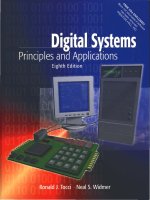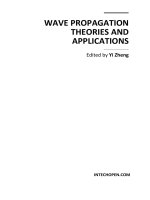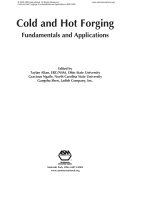Foam Engineering: Fundamentals and Applications docx
Bạn đang xem bản rút gọn của tài liệu. Xem và tải ngay bản đầy đủ của tài liệu tại đây (8.35 MB, 536 trang )
Foam Engineering
Stevenson_ffirs.indd iStevenson_ffirs.indd i 12/8/2011 4:48:50 PM12/8/2011 4:48:50 PM
Foam Engineering
Fundamentals and Applications
Edited by
Paul Stevenson
Department of Chemical and Materials Engineering,
Faculty of Engineering, University of Auckland, New Zealand
A John Wiley & Sons, Ltd., Publication
Stevenson_ffirs.indd iiiStevenson_ffirs.indd iii 12/8/2011 4:48:50 PM12/8/2011 4:48:50 PM
This edition first published 2012
© 2012 John Wiley & Sons, Ltd
Registered Office
John Wiley & Sons, Ltd, The Atrium, Southern Gate, Chichester, West Sussex, PO19 8SQ, United Kingdom
For details of our global editorial offices, for customer services and for information about how to apply for permission to reuse
the copyright material in this book please see our website at www.wiley.com.
The right of the author to be identified as the author of this work has been asserted in accordance with the Copyright, Designs
and Patents Act 1988.
All rights reserved. No part of this publication may be reproduced, stored in a retrieval system, or transmitted, in any form or
byany means, electronic, mechanical, photocopying, recording or otherwise, except as permitted by the UK Copyright, Designs
and Patents Act 1988, without the prior permission of the publisher.
Wiley also publishes its books in a variety of electronic formats. Some content that appears in print may not be available in
electronic books.
Designations used by companies to distinguish their products are often claimed as trademarks. All brand names and product
names used in this book are trade names, service marks, trademarks or registered trademarks of their respective owners. The
publisher is not associated with any product or vendor mentioned in this book. This publication is designed to provide accurate
and authoritative information in regard to the subject matter covered. It is sold on the understanding that the publisher is not
engaged in rendering professional services. If professional advice or other expert assistance is required, the services of a
competent professional should be sought.
The publisher and the author make no representations or warranties with respect to the accuracy or completeness of the
contentsof this work and specifically disclaim all warranties, including without limitation any implied warranties of fitness
foraparticular purpose. This work is sold with the understanding that the publisher is not engaged in rendering professional
services. The advice and strategies contained herein may not be suitable for every situation. In view of ongoing research,
equipment modifications, changes in governmental regulations, and the constant flow of information relating to the use of
experimental reagents, equipment, and devices, the reader is urged to review and evaluate the information provided in the
package insert or instructions for each chemical, piece of equipment, reagent, or device for, among other things, any changes
inthe instructions or indication of usage and for added warnings and precautions. The fact that an organization or Website
isreferred to in this work as a citation and/or a potential source of further information does not mean that the author or the
publisher endorses the information the organization or Website may provide or recommendations it may make. Further, readers
should be aware that Internet Websites listed in this work may have changed or disappeared between when this work was written
and when it is read. No warranty may be created or extended by any promotional statements for this work. Neither the publisher
nor the author shall be liable for any damages arising herefrom.
Library of Congress Cataloging-in-Publication Data
Foam engineering : fundamentals and applications / [edited by] Paul Stevenson. – 1st ed.
p. cm.
Includes bibliographical references and index.
ISBN 978-0-470-66080-5 (hardback)
1. Foam. 2. Foam–Industrial applications. 3. Foam–Technological innovations. 4. Foamed materials.
I. Stevenson, Paul, 1973–
QD549.F59 2012
620.1–dc23
2011037211
A catalogue record for this book is available from the British Library.
Print ISBN: 9780470660805
Set in 10/12pt Times by SPi Publisher Services, Pondicherry, India
Stevenson_ffirs.indd ivStevenson_ffirs.indd iv 12/8/2011 4:48:51 PM12/8/2011 4:48:51 PM
Contents
About the Editor xiii
List of Contributors xv
Preface xvii
1 Introduction 1
Paul Stevenson
1.1 Gas–Liquid Foam in Products and Processes 1
1.2 Content of This Volume 2
1.3 A Personal View of Collaboration in Foam Research 3
Part I Fundamentals 5
2 Foam Morphology 7
Denis Weaire, Steven T. Tobin, Aaron J. Meagher and Stefan Hutzler
2.1 Introduction 7
2.2 Basic Rules of Foam Morphology 7
2.2.1 Foams, Wet and Dry 7
2.2.2 The Dry Limit 9
2.2.3 The Wet Limit 11
2.2.4 Between the Two Limits 11
2.3 Two-dimensional Foams 11
2.3.1 The Dry Limit in 2D 11
2.3.2 The Wet Limit in 2D 12
2.3.3 Between the Two Limits in 2D 12
2.4 Ordered Foams 15
2.4.1 Two Dimensions 15
2.4.2 Three Dimensions 16
2.5 Disordered Foams 19
2.6 Statistics of 3D Foams 20
2.7 Structures in Transition: Instabilities and Topological Changes 21
2.8 Other Types of Foams 22
2.8.1 Emulsions 22
2.8.2 Biological Cells 22
2.8.3 Solid Foams 23
2.9 Conclusions 24
Acknowledgements 24
References 25
Stevenson_ftoc.indd vStevenson_ftoc.indd v 12/5/2011 9:04:21 PM12/5/2011 9:04:21 PM
vi Contents
3 Foam Drainage 27
Stephan A. Koehler
3.1 Introduction 27
3.2 Geometric Considerations 29
3.3 A Drained Foam 33
3.4 The Continuity Equation 35
3.5 Interstitial Flow 36
3.6 Forced Drainage 38
3.7 Rigid Interfaces and Neglecting Nodes: The Original
Foam Drainage Equation 41
3.8 Mobile Interfaces and Neglecting Nodes 43
3.9 Neglecting Channels: The Node-dominated Model 46
3.10 The Network Model: Combining Nodes and Channels 48
3.11 The Carman – Kozeny Approach 50
3.12 Interpreting Forced Drainage Experiments: A Detailed Look 51
3.13 Unresolved Issues 53
3.14 A Brief History of Foam Drainage 54
References 55
4 Foam Ripening 59
Olivier Pitois
4.1 Introduction 59
4.2 The Very Wet Limit 59
4.3 The Very Dry Limit 61
4.3.1 Inter-bubble Gas Diffusion through Thin Films 61
4.3.2 von Neumann Ripening for 2D Foams 62
4.3.3 3D Coarsening 64
4.4 Wet Foams 65
4.5 Controlling the Coarsening Rate 69
4.5.1 Gas Solubility 69
4.5.2 Resistance to Gas Permeation 70
4.5.3 Shell Mechanical Strength 70
4.5.4 Bulk Modulus 71
References 72
5 Coalescence in Foams 75
Annie Colin
5.1 Introduction 75
5.2 Stability of Isolated Thin Films 76
5.2.1 Experimental Studies Dealing with Isolated Thin Liquid Films 76
5.2.2 Theoretical Description of the Rupture of an Isolated
Thin Liquid Film 77
5.3 Structure and Dynamics of Foam Rupture 78
5.4 What Are the Key Parameters in the Coalescence Process? 81
Stevenson_ftoc.indd viStevenson_ftoc.indd vi 12/5/2011 9:04:22 PM12/5/2011 9:04:22 PM
Contents vii
5.5 How Do We Explain the Existence of a Critical Liquid Fraction? 86
5.6 Conclusion 89
References 89
6 Foam Rheology 91
Nikolai D. Denkov, Slavka S. Tcholakova, Reinhard Höhler
and Sylvie Cohen-Addad
6.1 Introduction 91
6.2 Main Experimental and Theoretical Approaches 93
6.3 Foam Visco-elasticity 95
6.3.1 Linear Elasticity 95
6.3.2 Non-linear Elasticity 98
6.3.3 Linear Relaxations 99
6.3.4 Shear Modulus of Particle-laden Foams 102
6.4 Yielding 103
6.5 Plastic Flow 105
6.6 Viscous Dissipation in Steadily Sheared Foams 106
6.6.1 Predominant Viscous Friction in the Foam Films 108
6.6.2 Predominant Viscous Friction in the Surfactant
Adsorption Layer 111
6.7 Foam–Wall Viscous Friction 112
6.8 Conclusions 114
Abbreviations 115
Acknowledgement 115
References 116
7 Particle Stabilized Foams 121
G. Kaptay and N. Babcsán
7.1 Introduction 121
7.2 A Summary of Some Empirical Observations 123
7.3 On the Thermodynamic Stability of Particle Stabilized Foams 125
7.4 On the Ability of Particles to Stabilize Foams during
Their Production 131
7.5 Design Rules for Particle Stabilized Foams 135
7.6 Conclusions 138
Acknowledgement 138
References 138
8 Pneumatic Foam 145
Paul Stevenson and Xueliang Li
8.1 Preamble 145
8.2 Vertical Pneumatic Foam 145
8.2.1 Introduction 145
8.2.2 The Hydrodynamics of Vertical Pneumatic Foam 147
Stevenson_ftoc.indd viiStevenson_ftoc.indd vii 12/5/2011 9:04:22 PM12/5/2011 9:04:22 PM
viii Contents
8.2.3 The ‘Vertical Foam Misapprehension’ 152
8.2.4 Bubble Size Distributions in Foam 153
8.2.5 Non-overflowing Pneumatic Foam 153
8.2.6 The Influence of Humidity upon Pneumatic Foam
with a Free Surface 155
8.2.7 Wet Pneumatic Foam and Flooding 155
8.2.8 Shear Stress Imparted by the Column Wall 157
8.2.9 Changes in Flow Cross-sectional Area 158
8.3 Horizontal Flow of Pneumatic Foam 158
8.3.1 Introduction 158
8.3.2 Lemlich’s Observations 159
8.3.3 Wall-slip and Velocity Profiles 160
8.3.4 Horizontal Flow Regimes 161
8.4 Pneumatic Foam in Inclined Channels 162
8.5 Methods of Pneumatic Foam Production 162
Nomenclature 164
References 165
9 Non-aqueous Foams: Formation and Stability 169
Lok Kumar Shrestha and Kenji Aramaki
9.1 Introduction 169
9.1.1 Foam Formation and Structures 169
9.1.2 Foam Stability 170
9.2 Phase Behavior of Diglycerol Fatty Acid Esters in Oils 173
9.3 Non-aqueous Foaming Properties 174
9.3.1 Effect of Solvent Molecular Structure 174
9.3.2 Effect of Surfactant Concentration 177
9.3.3 Effect of Hydrophobic Chain Length of Surfactant 181
9.3.4 Effect of Headgroup Size of Surfactant 187
9.3.5 Effect of Temperature 189
9.3.6 Effect of Water Addition 191
9.3.7 Non-aqueous Foam Stabilization Mechanism 201
9.4 Conclusion 203
Acknowledgements 203
References 204
10 Suprafroth: Ageless Two-dimensional Electronic Froth 207
Ruslan Prozorov and Paul C. Canfield
10.1 Introduction 207
10.2 The Intermediate State in Type-I Superconductors 208
10.3 Observation and Study of the Tubular Intermediate
State Patterns 211
10.4 Structural Statistical Analysis of the Suprafroth 215
Acknowledgements 224
References 224
Stevenson_ftoc.indd viiiStevenson_ftoc.indd viii 12/5/2011 9:04:22 PM12/5/2011 9:04:22 PM
Contents ix
Part II Applications 227
11 Froth Phase Phenomena in Flotation 229
Paul Stevenson and Noel W.A. Lambert
11.1 Introduction 229
11.2 Froth Stability 233
11.3 Hydrodynamic Condition of the Froth 235
11.4 Detachment of Particles from Bubbles 236
11.5 Gangue Recovery 238
11.6 The Velocity Field of Froth Bubbles 241
11.7 Plant Experience of Froth Flotation 242
11.7.1 Introduction 242
11.7.2 Frother-constrained Plant 242
11.7.3 Sampling, Data Manipulation and Data Presentation 244
11.7.4 Process Control 245
11.7.5 The Assessment of Newly Proposed Flotation Equipment 246
11.7.6 Conclusions about Froth Flotation Drawn from Plant Experience 246
Nomenclature 246
References 247
12 Froth Flotation of Oil Sand Bitumen 251
Laurier L. Schramm and Randy J. Mikula
12.1 Introduction 251
12.2 Oil Sands 251
12.3 Mining and Slurrying 253
12.4 Froth Structure 265
12.5 Physical Properties of Froths 272
12.6 Froth Treatment 274
12.7 Conclusion 278
Acknowledgements 278
References 278
13 Foams in Enhancing Petroleum Recovery 283
Laurier L. Schramm and E. Eddy Isaacs
13.1 Introduction 283
13.2 Foam Applications for the Upstream Petroleum Industry 284
13.2.1 Selection of Foam-Forming Surfactants 284
13.3 Foam Applications in Wells and Near Wells 287
13.3.1 Drilling and Completion Foams 287
13.3.2 Well Stimulation Foams: Fracturing, Acidizing, and Unloading 288
13.4 Foam Applications in Reservoir Processes 289
13.4.1 Reservoir Recovery Background 289
13.4.2 Foam Applications in Primary and Secondary Oil Recovery 292
13.4.3 Foam Applications in Enhanced (Tertiary) Oil Recovery 293
Stevenson_ftoc.indd ixStevenson_ftoc.indd ix 12/5/2011 9:04:22 PM12/5/2011 9:04:22 PM
x Contents
13.5 Occurrences of Foams at the Surface and Downstream 298
13.6 Conclusion 299
References 299
14 Foam Fractionation 307
Xueliang Li and Paul Stevenson
14.1 Introduction 307
14.2 Adsorption in Foam Fractionation 310
14.2.1 Adsorption Kinetics at Quiescent Interface 311
14.2.2 Adsorption at Dynamic Interfaces 314
14.3 Foam Drainage 315
14.4 Coarsening and Foam Stability 316
14.5 Foam Fractionation Devices and Process Intensification 317
14.5.1 Limitations of Conventional Columns 317
14.5.2 Process Intensification Devices 319
14.6 Concluding Remarks about Industrial Practice 324
Nomenclature 325
References 326
15 Gas–Liquid Mass Transfer in Foam 331
Paul Stevenson
15.1 Introduction 331
15.2 Non-overflowing Pneumatic Foam Devices 334
15.3 Overflowing Pneumatic Foam Devices 336
15.4 The Waldhof Fermentor 338
15.5 Induced Air Methods 340
15.6 Horizontal Foam Contacting 341
15.7 Calculation of Specific Interfacial Area in Foam 342
15.8 Hydrodynamics of Pneumatic Foam 343
15.9 Mass Transfer and Equilibrium Considerations 345
15.9.1 Gas–Liquid Equilibrium 345
15.9.2 Rate of Mass Transfer 345
15.9.3 Estimation of Mass Transfer Coefficient 346
15.10 Towards an Integrated Model of Foam Gas–Liquid
Contactors 347
15.11 Discussion and Future Directions 349
Nomenclature 351
Acknowledgements 351
References 352
16 Foams in Glass Manufacturing 355
Laurent Pilon
16.1 Introduction 355
16.1.1 The Glass Melting Process 356
16.1.2 Melting Chemistry and Refining 359
16.1.3 Motivations 362
Stevenson_ftoc.indd xStevenson_ftoc.indd x 12/5/2011 9:04:22 PM12/5/2011 9:04:22 PM
Contents xi
16.2 Glass Foams in Glass Melting Furnaces 363
16.2.1 Primary Foam 363
16.2.2 Secondary Foam 363
16.2.3 Reboil 364
16.2.4 Parameters Affecting Glass Foaming 365
16.3 Physical Phenomena 365
16.3.1 Glass Foam Physics 365
16.3.2 Surface Active Agents and Surface Tension of Gas/Melt Interface 368
16.3.3 Drainage and Stability of a Single Molten Glass Film 369
16.3.4 Gas Bubbles in Molten Glass 370
16.4 Experimental Studies 373
16.4.1 Introduction 373
16.4.2 Transient Primary and Secondary Glass Foams 374
16.4.3 Steady-state Glass Foaming by Gas Injection 384
16.5 Modeling 386
16.5.1 Introduction 386
16.5.2 Dynamic Foam Growth and Decay 387
16.5.3 Steady-state Glass Foams 389
16.5.4 Experiments and Model Limitations 395
16.6 Measures for Reducing Glass Foaming in Glass Melting Furnaces 396
16.6.1 Batch Composition 396
16.6.2 Batch Conditioning and Heating 397
16.6.3 Furnace Temperature 397
16.6.4 External and Temporary Actions 397
16.6.5 Atmosphere Composition and Flame Luminosity 399
16.6.6 Control Foaming in Reduced-pressure Refining 400
16.7 Perspective and Future Research Directions 401
Acknowledgements 402
References 402
17 Fire-fighting Foam Technology 411
Thomas J. Martin
17.1 Introduction 411
17.2 History 413
17.3 Applications 415
17.3.1 Foam Market 415
17.3.2 Hardware 415
17.4 Physical Properties 416
17.4.1 Mechanism of Action 417
17.4.2 Class A Foams 422
17.4.3 Class B Foams 422
17.5 Chemical Properties 430
17.5.1 Ingredients and Purpose 430
17.5.2 Example Recipes 447
17.6 Testing 448
17.6.1 Lab Test Methods 449
17.6.2 Fire Test Standards 452
Stevenson_ftoc.indd xiStevenson_ftoc.indd xi 12/5/2011 9:04:22 PM12/5/2011 9:04:22 PM
xii Contents
17.7 The Future 453
Acknowledgements 454
References 454
18 Foams in Consumer Products 459
Peter J. Martin
18.1 Introduction 459
18.1.1 Foams and Consumer Appeal 459
18.1.2 Market Descriptions and Directions 461
18.1.3 The Scope of This Chapter 463
18.2 Creation and Structure 463
18.2.1 Surfactants and Their Application 464
18.2.2 Creation 466
18.2.3 Growth 468
18.2.4 Application of Structure 469
18.2.5 Maintenance of Structure 469
18.2.6 Summary 470
18.3 Sensory Appeal 470
18.3.1 Visual 471
18.3.2 Auditory 472
18.3.3 Mouth Feel 473
18.3.4 Summary 473
18.4 Conclusions 473
References 473
19 Foams for Blast Mitigation 477
A. Britan, H. Shapiro and G. Ben-Dor
19.1 Introduction 477
19.2 Free Field Tests 478
19.2.1 Compressibility 478
19.2.2 Typical Test Rigs 480
19.2.3 Decay of the Foam Barrier 482
19.2.4 Effect of Foam Density 485
19.2.5 Foam Impedance and the Barrier Thickness 488
19.3 Shock Tube Testing 493
19.3.1 Main Restrictions 493
19.3.2 Foam Shattering 494
19.4 Theoretical Approaches 497
19.4.1 Governing Processes 497
19.4.2 Hierarchy of the Process 498
19.5 Conclusions 508
Acknowledgements 509
References 509
Index 513
Stevenson_ftoc.indd xiiStevenson_ftoc.indd xii 12/5/2011 9:04:22 PM12/5/2011 9:04:22 PM
Paul Stevenson is a senior lecturer in the Chemical and Materials Engineering Department
of the University of Auckland, New Zealand. He took BA (Hons) and MEng degrees in
chemical engineering from the University of Cambridge, UK, where he completed doctoral
studies in multiphase flow in oil flowlines. After post-doctoral research with the 2nd
Consortium on Transient Multiphase Flow at Cambridge, he took a position at the University
of Newcastle, Australia, to investigate froth flotation and foam fractionation. He has worked
as a process chemist for Allied Colloids and as a chemical engineer for Croda Hydrocarbons
and British Steel Technical, all in the UK. In addition he has spent periods as a Japanese
convertible bond dealer for the US investment bank D.E. Shaw Securities International and
a racecourse bookmaker for his family’s business.
About the Editor
Stevenson_fbetw.indd xiiiStevenson_fbetw.indd xiii 12/6/2011 10:09:50 PM12/6/2011 10:09:50 PM
Kenji Aramaki
Graduate School of Environment and
Information Sciences, Yokohama National
University, Yokohama, Japan
N. Babcsán
BAY-ZOLTAN Foundation for Applied
Research, Miskolc-Tapolca, Igloói, Hungary
G. Ben-Dor
Protective Technologies R&D Center,
Faculty of Engineering Sciences,
Ben-Gurion University of the Negev,
BeerSheva, Israel
A. Britan
Protective Technologies R&D Center,
Faculty of Engineering Sciences,
Ben-Gurion University of the Negev,
BeerSheva, Israel
Paul C. Canfield
Department of Physics and Astronomy,
Ames Laboratory, Iowa State University,
Ames, IA, USA
Sylvie Cohen-Addad
Université Paris 6, Paris, France, and
Université Paris-Est, Marne-la-Vallée, France
Annie Colin
Université Bordeaux, Pessac, France
Nikolai D. Denkov
Department of Chemical Engineering,
Faculty of Chemistry, Sofia University,
Sofia, Bulgaria
Reinhard Höhler
Université Paris 6, Paris, France, and
Université Paris-Est, Marne-la-Vallée,
France
S. Hutzler
School of Physics, Trinity College,
Dublin, Ireland
E. Eddy Isaacs
Alberta Innovates – Energy and
Environment Solutions, Calgary, AB,
Canada
G. Kaptay
BAY-ZOLTAN Foundation for Applied
Research, Miskolc-Tapolca, Iglói,
Hungary, and University of Miskolc,
Egyetemváros, Miskolc, Hungary
Stephan A. Koehler
Physics Department, Worcester
Polytechnic Institute, Worcester, MA, USA
Noel W.A. Lambert
Clean Process Technologies Pty Ltd,
Lower Belford, NSW, Australia
Xueliang Li
Centre for Advanced Particle Processing,
University of Newcastle, Callaghan,
Australia
Peter J. Martin
School of Chemical Engineering and
Analytical Science, The University of
Manchester, Manchester, UK
List of Contributors
Stevenson_fbetw.indd xvStevenson_fbetw.indd xv 12/6/2011 10:09:50 PM12/6/2011 10:09:50 PM
xvi Contributors
Thomas J. Martin
Chemical Technology and Quality
Assurance,
Research & Development,
Chemguard, Inc.,
Mansfield, TX, USA
A.J. Meagher
School of Physics, Trinity College,
Dublin, Ireland
Randy J. Mikula
Natural Resources Canada, Devon, AB,
Canada
Laurent Pilon
Henry Samueli School of Engineering and
Applied Science, Mechanical and
Aerospace Engineering Department,
University of California Los Angeles,
Los Angeles, CA, USA
Olivier Pitois
Université Paris-Est, Laboratoire Navier,
IFSTTAR, France
Ruslan Prozorov
Department of Physics and Astronomy,
Ames Laboratory, Iowa State University,
Ames, IA, USA
Laurier L. Schramm
Saskatchewan Research Council,
Saskatoon, SK, Canada
H. Shapiro
Protective Technologies R&D Center,
Faculty of Engineering Sciences,
Ben-Gurion University of the Negev,
BeerSheva, Israel
Lok Kumar Shrestha
International Center for Young Scientists,
WPI Center for Materials
Nanoarchitectonics, National Institute
forMaterials Science, Tsukuba Ibaraki,
Japan
Paul Stevenson
Department of Chemical and Materials
Engineering, Faculty of Engineering,
University of Auckland, NewZealand
Slavka S. Tcholakova
Department of Chemical Engineering,
Faculty of Chemistry, Sofia University,
Sofia, Bulgaria
S.T. Tobin
School of Physics, Trinity College, Dublin,
Ireland
D. Weaire
School of Physics, Trinity College, Dublin,
Ireland
Stevenson_fbetw.indd xviStevenson_fbetw.indd xvi 12/6/2011 10:09:50 PM12/6/2011 10:09:50 PM
I am enormously grateful to all of authors who have contributed to this volume on gas–
liquid foam. One of the great pleasures of working with such accomplished scientists and
engineers from industry and academia is that everybody has known the level at which to
pitch their contributions.
Special thanks are due to Laurie Schramm who, along with co-authors, has contributed
two chapters on foams in enhanced oil recovery and flotation of oil sands, and to Thomas
Martin who endured initial confusion upon my part to produce a first class chapter on fire-
fighting foams. I’d like to express my gratitude to Stephan Koehler for giving me sound
advice about the selection of authors for various chapters, and to Denis Weaire who advised
upon how to engender more coherence in the volume. Cat Chimney gave sterling assistance
in formatting referencing styles of a number of chapters. My former colleague Noel
Lambert delivered excellent copy at tremendously short notice despite being in enormous
demand by others. Gratitude is due to Sven Schröter (of Schroeter Imagery) for his excellent
photography and production of the image on the cover of this volume. I could not have
completed this project without the constant and faithful assistance of my doctoral student
and friend Xueliang (Bruce) Li. Bruce co-wrote two chapters with me, reviewed other
chapters and developed ideas for cover art. He is truly a gentleman and scholar.
Thanks should also go to the staff at Wiley (Chichester), in particular Rebecca Stubbs,
Sarah Tilley and Amie Marshall, who first envisaged this project and gave excellent support
as the volume developed.
Last but not least I’d like to thank my second daughter, Charlotte, for being born at a
perfect time to enable me to claim my nine weeks paternity leave from the University of
Auckland, during which I worked upon this volume, as well as my wife Tracey for giving
birth to her and my first daughter Emily for being cute.
Preface
Stevenson_fpref.indd xviiStevenson_fpref.indd xvii 12/6/2011 8:25:47 PM12/6/2011 8:25:47 PM
Plate 1: Fig. 12.10 Confocal micrograph of a bitumen froth (deaerated) from an easily
processed ore.The mineral is colored red and the bitumen is green. Most of the mineral is
associated with the water phase that has been trapped as the bitumen bubbles collapsed
atthe top of the separation cell. Photomicrograph by V. Muñoz.
Plate 2: Fig. 12.12 Confocal micrograph of a bitumen froth (deaerated) from a difficult to
process ore. The mineral is colored red and the bitumen is green. Most of the mineral in this
case is closely associated with the bitumen (oil wet solids) and a very complex emulsified
froth structure is observed due to the high surfactant concentration in the bitumen. The
bitumen component is imaged in a fluorescent mode and the decreased brightness in this
image relative to Fig. 12.11 is indicative of a different bitumen chemistry in the bitumen
component. Photomicrograph by V. Muñoz.
Stevenson_bins.indd 1Stevenson_bins.indd 1 12/12/2011 12:23:56 PM12/12/2011 12:23:56 PM
Plate 3: Fig. 12.14 The loose froth (left) is from the same oil sand as the coalesced froth
(right). Theuse of sodium hydroxide in the extraction process changes the nature of the
bitumen, resulting in a froth that has significantly less mineral and water. In these confocal
microscope images, the red colors are mineral components, the green are hydrocarbon, and
the dark areas are water. Photomicrographs by V. Muñoz.
Plate 4: Fig. 12.17 A detail of a similar membranous sac at higher magnification showing
both mineral (red) and organic phases (green). The stronger the association between the
mineral and organic components, the greater is the proportion of yellow in this image.
Photomicrograph by V. Muñoz.
Stevenson_bins.indd 2Stevenson_bins.indd 2 12/12/2011 12:23:59 PM12/12/2011 12:23:59 PM
(a) (b) (c)
(d) (e)
Plate 5: Fig. 19.3 (a–c) Typical arrangements of the foam barrier for internal explosion case;(d and e) the effect on the van of a blast from
an explosion of a 44 kg charge of C4 (d: not protected; e: protected).
Stevenson_bins.indd 3Stevenson_bins.indd 3 12/12/2011 12:24:02 PM12/12/2011 12:24:02 PM
(a)
Wire/plastic foam
supporting fence
Gauge stand
1.8 m
6m
6m
Charge
(b)
Fire hose
Nozzle
Plate 6: Fig. 19.4 (a) Layout and (b) typical dimensions of a rig used for testing the close field of an internal explosion [19].
Stevenson_bins.indd 4Stevenson_bins.indd 4 12/12/2011 12:24:08 PM12/12/2011 12:24:08 PM
Foam Engineering: Fundamentals and Applications, First Edition. Edited by Paul Stevenson.
© 2012 John Wiley & Sons, Ltd. Published 2012 by John Wiley & Sons, Ltd.
1
Introduction
Paul Stevenson
1.1 Gas–Liquid Foam in Products and Processes
A gas–liquid foam, such as those found on the top of one’s bath or one’s beer, is a multiphase
mixture that generally exhibits several physical properties that make it amenable to be used
in multifarious industrial applications:
1. High specific surface area. The amount of gas–liquid surface area per unit volume of
material that is attainable in a foam is greater than that in comparable two-phase systems.
This property makes gas–liquid foam particularly attractive for interphase mass transfer
operations. Examples of such processes are froth flotation, in which valuable hydrophobic
particles are recovered from a slurry, the recovery of oil sands, and the stripping of gases
from effluent by absorption into the liquid phase.
2. Low interphase slip velocity. The slip velocity between gas and liquid phases is the
absolute velocity of the liquid phase relative to the gas phase, and this is typically much
smaller in a foam than in a bubbly gas–liquid mixture. This is because the large specific
surface area is able to impart a relatively large amount of shear stress on the liquid
phase, thereby limiting the relative slip velocity between phases. A high contact time
between gas and liquid phases can be engendered, which can also enhance the amount
of mass transfer from liquid to gas, gas to liquid, or liquid to interface.
3. Large expansion ratio. Because the volumetric liquid fraction of a foam can be very
low, the expansion ratio (i.e. the quotient of total volume and the volume of liquid used
to create that foam) can be very high. This property is harnessed in the use of the material
for fighting fires and to displace hydrocarbons from reservoirs.
Stevenson_c01.indd 1Stevenson_c01.indd 1 12/3/2011 3:28:03 AM12/3/2011 3:28:03 AM
2 Foam Engineering
4. A finite yield stress. Because gas–liquid foams can support a finite shear stress before
exhibiting strain, they are very effective for use in delivering active agents contained in
liquids in household and personal care products (such as bathroom cleaner and shaving
foam), as well as in topical pharmaceutical treatments.
Thus, the geometrical, hydrodynamical and rheological properties of gas–liquid foam
can be harnessed to make it a uniquely versatile multiphase mixture for a variety of process
applications and product designs. It is therefore a material that is of broad interest to
chemical engineers.
However, these physical properties of gas–liquid foam are determined by the underlying
physics of the material. The rheology of foam is dependent upon, inter alia, the liquid
fraction in the foam, which is in turn dependent of the rate of liquid drainage. This is a
function of the rate at which bubbles coalesce and how the bubble size distribution evolves
because of inter-bubble gas diffusion. The performance of a froth flotation column is
dependent upon the stability of the foam, but the very attachment of particles to interfaces
can have a profound influence upon this stability. In fact, the underlying physical processes
that dictate the performance of a foam in a process or product application are generally
highly interdependent.
It is precisely because of this interdependency, and how the interdependent fundamental
physical processes impact upon the applications of foam, that it is hoped that this volume
will have utility, for it seems axiomatic that those motivated by applications of foam would
need to know about the underlying physics, and vice versa.
1.2 Content of This Volume
This volume is split into two major sections, within which the chapters broadly:
1. Give a treatment of one or another aspect of the fundamental physical nature or
behaviour of gas–liquid foam
2. Consider a process or product application of foam
The first part provides a chapter in which the topology of gas–liquid foam is described
followed by expositions of how this can change through liquid drainage, inter-bubble gas
diffusion and coalescence, although these processes are highly mutually interdependent.
Further, there are chapters on the rheology of foam and how particles can enhance stability,
since these topics are rooted in fundamental physics, but have an important impact upon
applications of foam. There is a chapter on the hydrodynamics of pneumatic foam, which
underpins the processes of froth flotation, foam fractionation and gas–liquid mass transfer,
and one on the formation and stability of non-aqueous foams. Finally in the ‘Fundamentals’
section there is a chapter on ‘Suprafroth’, which is a novel class of magnetic froth in which
coarsening is promoted by the application of a magnetic field and therefore is reversible.
In the second part, ‘Applications’, there are chapters on processes and products that
exploit the properties of foam. Froth flotation, foam fractionation and foam gas absorption
are unit operations for different types of separation processes that rely upon pneumatic
gas–liquid foam for their operation, and each is treated in an individual chapter. In addition
Stevenson_c01.indd 2Stevenson_c01.indd 2 12/3/2011 3:28:04 AM12/3/2011 3:28:04 AM
Introduction 3
there is a dedicated chapter on the flotation of oil sands because the technical challenges of
this process are dissimilar to those of phase froth flotation of minerals and coal and because
the supply of hydrocarbon resources from this source is likely to become increasingly
important over the next century. However, foams also find utility in the enhanced recovery
from oil reservoirs and this is described in a chapter. Foams manifest in a variety of
manufacturing processes, and there is a description of foam behaviour and control in the
production of glass. One of the most common applications of foam is in firefighting, as is
discussed in a dedicated chapter. There is an important chapter on the creation and
application of foams in consumer products; such products are typically of high added-value
and therefore this field is rich with opportunities for innovation and development. Finally,
a chapter on blast-mitigation using foam is given.
1.3 A Personal View of Collaboration in Foam Research
I had been doing postdoctoral work in the UK into multiphase flow through subsea oil
flowlines when, in 2002, I travelled to Newcastle, Australia, to commence research on froth
flotation of coal. I confess to not knowing what flotation was, but when I was travelling to
work by train on my first morning I saw a coal train pass that seemed to be at least one mile
long, so I thought it must be a field worthy of engagement. I had never considered foams
beyond those encountered in domestic life.
However, once in Australia, it soon became clear to me that there was nothing specific for
me to do, so I was left to my own devices from the outset. I inherited a pneumatic foam
column that lived in a dingy dark-room, and for six months I would go there each morning
and watch foam rise up a column and collect the overflow in a bucket. When it got too hot, I
went to the excellent and well-air-conditioned library to read about foam drainage. Iespecially
remember reading articles on drainage of Denis Weaire’s (co-author of Chapter 2 herein)
group from Trinity College Dublin, and the work that Stephan Koehler (author of Chapter 3)
carried out at Harvard. Despite having had a relatively rigorous education in a good chemical
engineering department, I felt totally out of my depth when trying to get to grips with this
work. I’d come across vector notation as an undergraduate, but it still daunted me. One
afternoon I read the words ‘self-similar ansatz’, and immediately retired for the day. During
this time, I shared an office with Noel Lambert (joint author of Chapter 11), now Chief
Process Engineer of CleanProTech, who would come into the office coated in coal dust and
issue instructions down the telephone to organise the next day’s flotation plant trials. I found
the mathematical approach of Denis and Stephan difficult to comprehend, but Noel’s world
was completely alien to me. And yet we were all working on one or another aspect of foam.
I learnt enough from Noel to realise that flotation was an incredibly physically complicated
process and that plant experience was of paramount importance when trying to improve and
innovate. In this context, methods that claimed to be able to simulate the entire flotation
process by numerical solutions of sets of equations based upon oversimplified physics
seemed particularly contrived. Similarly, there was a plethora of dimensionally inconsistent
data fits in the flotation literature that were by their very nature only relevant to the experiments
from which they were developed, but upon which general predictive capability was claimed.
It is not surprising that some physicists appear to view some work of engineers with caution.
Stevenson_c01.indd 3Stevenson_c01.indd 3 12/3/2011 3:28:04 AM12/3/2011 3:28:04 AM
4 Foam Engineering
However, it was a chemical engineer who, arguably, was the first researcher to make
significant process in both the fundamental science of gas–liquid foam and the process
applications. Among his many achievements, Robert Lemlich of the University of
Cincinnati proposed what is often now known as the ‘channel-dominated foam drainage
model’, and he used this to propose a preliminary mechanistic model for the process of
foam fractionation. Thus, the desire for a better understanding of a process technology for
the separation of surface-active molecules from aqueous solution was the driver for the
development of what some regard as the ‘standard model’ of foam drainage. Robert
Lemlich’s career was characterised by trying to describe and innovate process technologies
that harnessed foam by building a better understanding of the underlying physics. Lemlich’s
contributions, which are often not given the credit that they deserve, demonstrate the value
of a combined approach of physical understanding and practical application. Lemlich, and
his co-workers, were able to effect these developments within their own research group.
Those of us who do not possess Lemlich’s skill and insight may not be able to make similar
progress single-handedly, but can still benefit from cross-disciplinary collaboration to
achieve similar goals.
As a chemical engineer working on the fundamentals of gas–liquid foam and its process
applications, I have collaborated with physicists and have found that the biggest impediments
to interdisciplinary research in foam are caused by semantic problems. For example, as a
former student of chemical engineering, I learnt about Wallis’s models of one-dimensional
two-phase flow, and I therefore frequently invoke the concept of a ‘superficial velocity’
(i.e. the volumetric flowrate of a particular phase divided by the cross-sectional area of the
pipe or channel). However, I have discovered that this is not a term universally known by
the scientific community, and its use by me has caused some consternation in the past.
Equally, I am quite sure that I have inadvertently disregarded research studies because
Ihave failed to understand the language and methods correctly. However, I have recently
found that perseverance, an open mind and a willingness to ask and to answer what may
superficially appear to be trivial questions can overcome some difficulties.
The contributors to this volume may be from differing disciplines of science and
engineering, but all are leading experts in their fields and all are active in developing the
science and technology of foam fundamentals and applications. It is very much hoped that,
in bringing together this diverse cohort of authors into a single volume, genuine cross-
disciplinary research will be stimulated that can effectively address problems in the
fundamental nature of gas–liquid foam as well as innovate new processes that can harness
its unique properties. In addition, it is anticipated that engineering practitioners who design
products and processes that rely on gas–liquid foam will benefit from gaining an insight
into the physics of the material.
Stevenson_c01.indd 4Stevenson_c01.indd 4 12/3/2011 3:28:04 AM12/3/2011 3:28:04 AM
Part I
Fundamentals
Stevenson_p01.indd 5Stevenson_p01.indd 5 12/3/2011 3:28:37 AM12/3/2011 3:28:37 AM
Foam Engineering: Fundamentals and Applications, First Edition. Edited by Paul Stevenson.
© 2012 John Wiley & Sons, Ltd. Published 2012 by John Wiley & Sons, Ltd.
2
Foam Morphology
Denis Weaire, Steven T. Tobin, Aaron J. Meagher and Stefan Hutzler
2.1 Introduction
When bubbles congregate together to form a foam, they create fascinating structures that
change and evolve as they age [1], are deformed [2], or lose liquid [3]. Foams are usually
disordered mixtures of bubbles of many sizes, but they may also be monodisperse, in which
case ordered structures may also be found. They may be relatively wet or dry, i.e. contain
a greater or lesser amount of liquid.
While the familiar foams of industry and everyday life are three-dimensional, laboratory
experiments create two-dimensional foams of various kinds, offering attractive possibilities
of easy experiments, computer simulations and visualizations, and more elementary theory.
One form of 2D foam consists of a thin sandwich of bubbles between two glass plates. Let
us begin with the 3D case, recognizing its greater practical importance.
2.2 Basic Rules of Foam Morphology
2.2.1 Foams, Wet and Dry
Foams may be classified as dry or wet according to liquid content, which may be represented
by liquid volume fraction f. This ranges from much less than 1% to about 30%. Engineers
call the gas fraction (i.e. 1 − f) the foam quality. Foams used in firefighting are classified
by their expansion ratio, which is defined by f
−1
. At each extreme (the dry and wet limits)
Stevenson_c02.indd 7Stevenson_c02.indd 7 12/5/2011 11:21:10 PM12/5/2011 11:21:10 PM









